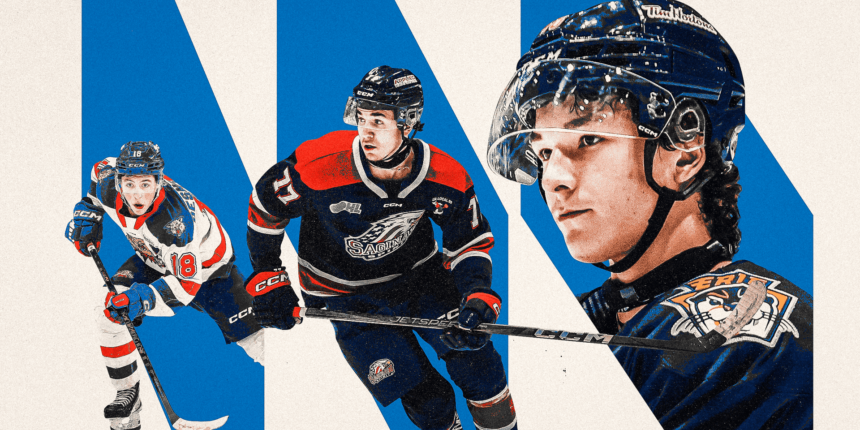As the season has gone along and we near postseason play in junior hockey, the 2025 NHL Draft class has shown steady improvements. I would argue it’s still below average, but there’s been enough upward trajectory that I could buy it being closer to an average class. Erie defenseman Matthew Schaefer is still my No. 1 ranked prospect and the favorite to go first despite his limited playing time this season due to injury. I would not qualify him as an absolute lock to be the top pick, though.
Ranked players are placed into tiers and given tool grades. Tool grades are based on a scale with six separate levels, with an eye toward how this attribute would grade in the NHL (poor, below-average, average, above-average, high-end and elite). “Average” on this scale means the tool projects as NHL average, which is meant as a positive, not a criticism. Skating, puck skills, hockey sense and compete for every projected NHL player are graded. Shot grades are only included if a shot is notably good or poor.
Player comparables are introduced for the first time for this draft class. This is my best attempt at giving readers an idea of what I think these prospects could realistically become in the NHL.
I’m ending my list at 32 players, but I can assure you that the “projected to play NHL games” tier is much longer than the few players I’ve listed today.
Loading
Try changing or resetting your filters to see more.
Schaefer has been tremendous, when healthy, this season. The No. 1 pick in his OHL Draft, Schaefer was arguably the best player at the Hlinka Gretzky and the CHL/U.S. NTDP series. He was also Canada’s best player at the World Juniors up until he broke his clavicle. Schaefer missed time at the start of the season due to mono as well. His main asset is his skating. He’s a powerful, effortless skater who will be able to close gaps and transition up ice at a clear NHL level. He uses his feet to attack often, leading and supporting rushes very well. Schaefer is a very intelligent defenseman with legit offensive skills. He creates a lot of chances due to his skating, but he can also break down opponents one-on-one with his hands, and finds a lot of seams to make plays. He closes on checks at a high level due to his athleticism, but Schaefer is also a great competitor. He uses his size to make stops, gives a great effort every shift and projects to be able to stop top players in the NHL. He’s a great talent, who has already overcome tremendous personal adversity in his life. He projects as a star No. 1 defenseman in the NHL.
Photo:
Brandon Soto / OHL Images


Tier 2
Bubble NHL All-Star and top of the lineup player
Misa was given exceptional status to play in the OHL as a 15-year-old. He looked very impressive in his first two seasons, but he’s taken off in his draft season, being the clear best player in the OHL. He’s a high-end skater with clear NHL edge work and top speed. He’s highly skilled and creative. He makes a lot of skilled plays at rapid speeds and projects to get a lot of controlled entries at the top level. I don’t know if Misa has the special offensive IQ to be a true PP1 flank type in the NHL, but he could be if needed. He’s average-sized but he goes to the net, gets back defensively and creates offense in a way that will translate to the NHL. He projects as a No. 1 center with a chance to be a star.
Photo:
Natalie Shaver / OHL Images


Desnoyers has been arguably the best player in the QMJHL this season as a leader on the top team in the league. The No. 1 pick in his QMJHL Draft, he checks every box for what you want in an NHL center. He’s tall and fast and makes a lot happen with and without the puck. Desnoyers displays excellent skill and playmaking ability. He creates offense on the move, off the perimeter and at the net. He has great creativity as a playmaker, while also being a detailed two-way player. Desnoyers can be trusted to check top players as he has a physical edge in his game and gives a high effort every game. He has the potential to be a No. 1 center who can play in any situation.
Photo:
David St. Louis / Moncton Wildcats


Hagens has played well for Boston College this season. His production hasn’t been as elite as some would have hoped after a sterling U.S. NTDP career, but he’s still been an important player on a great team. Hagens was also a go-to player for Team USA as they won gold at the World Juniors. He has a dynamic combination of skating and skill reminiscent of American centers like Logan Cooley and Jack Hughes. Hagens’ edge work is high-end and he’s extremely elusive in open ice. He makes a ton of difficult plays on the move and is a high-end playmaker. Hagens isn’t that big or physical, and can stay on the outside too much, but he gives a decent nightly effort and coaches tend to lean on him. He has the potential to be a play-driving top two line center in the NHL.
Photo:
Russell Hons / Cal Sport Media via AP Images


Martone has been a top player in the OHL this season, however, he did struggle at the World Juniors for Canada. Martone’s skill level and creativity with the puck are elite especially for a man his size. His reach and skill will allow him to beat a ton of NHL defenders one-on-one. He’s makes a lot of difficult plays and does so in traffic. Martone competes well, showing no hesitancy to engage physically or create at the net. Martone’s major issue is the pace in his game. When he turns the corner and gets up ice his foot speed is decent, but his first few steps are heavy, with a semi-wonky looking stride and he doesn’t always play with a ton of tempo. The size/skill combo is so good he could overcome that problem, but as one head scout has said, “Martone has the biggest weakness of any of the top five picks.” He projects as a top line scoring winger in the NHL who could put up a ton of points.
Photo:
Natalie Shaver / OHL Images


Tier 3
Top of the lineup player
Frondell’s season started off slow, in part due to injury, but he’s been his old self and on a tear in recent months against men in the Allsvenskan. Frondell has a ton of skill and a real smooth element when he’s around the puck. He makes difficult plays with consistency and can do so on the move. Frondell skates well and competes hard, often outmuscling others bigger than him so despite his average size, he has a translatable style of play to the NHL that appeals to scouts. Frondell is a great playmaker but he’s also a very dangerous shooter with a bullet shot that projects to beat NHL goalies from range. He has the potential to be a star No. 1 center even if he’s often played wing this season.
Photo:
Steven Ellis / Daily Faceoff


Eklund, the younger brother of Sharks winger William Eklund, has been excellent this season versus men in the Allsvenskan as well as for Sweden’s World Junior team. Victor is an excellent skater. He has good speed, but his edge work is what separates his skating ability and how elusive he is in tight. He’s a very skilled forward who makes creative plays and can do so in the tough areas. Eklund is undersized, but he plays like a big man. He’s a tenacious competitor who hunts down pucks and is great at creating chances around the net. He projects as a top-line winger.
Photo:
Steven Ellis / Daily Faceoff


McQueen got off to a great start to the season before a back injury sidelined him in the fall. He’s a 6-foot-5 center who, when healthy, can skate and has high-end offensive skills. He has game-breaking ability with the puck and can dominate a game. He’s extremely talented as a puckhandler, but he can also generate offense around the net and doesn’t shy from physical play. His consistency could be a bit better. For as talented as he is, I expected a bit more production last season, even if he was a point-per-game player in the WHL.
Photo:
Jeremy Champagne / Brandon Wheat Kings


Aitcheson has been one of the better defensemen in the OHL this season. He’s been a major minutes player for Barrie as he was for for Canada’s U18 team last spring. He’s a hyper-competitive defender who doesn’t back down from physical play and likes to agitate. He has the bite NHL teams will love, even if he does go over the line at times. He’s a good skater with strong enough hands and hockey sense to make plays at higher levels and a solid point shot too. Aitcheson won’t run a power play, lacking the natural sense at times with the puck, but he projects to have secondary NHL offense and has put up significant offense this year. Even if his puck play is just decent, with his athletic tools, and being a menace to play against he can be a great top-four defenseman.
Photo:
Terry Wilson / OHL Images


O’Brien has been an excellent junior player as a leading player on a top OHL team. O’Brien displays the high-end patience and vision to hold onto pucks for an extra second to make plays. He’s extremely skilled with the puck, showing the soft touch and quick hands to create NHL scoring chances and improvise on difficult plays often. O’Brien is also a competitive center who gets to the net, wins pucks and plays with good tempo. His foot speed is good enough for the NHL, too, even though I wouldn’t call him a blazer. He could be a second-line center.
Photo:
Kevin Sousa / Getty Images


Tier 4
Bubble top and middle of the lineup player
Smith has generated a lot of NHL interest due to his combination of tools and production. He’s a 6-foot-3 defenseman who skates quite well. He’s funky-looking at times going 10-2 with his edges a bit too much, but he’s a powerful, fluid skater who can easily get by checkers and skate pucks up ice. Smith often tries to attack with his skill and can break down players one-on-one easily. Smith’s decision-making isn’t the best at times and I wouldn’t call him a natural playmaker. Defensively, he’s decent due to his frame and feet, and when he’s leaning into checks he can be a two-way force. His defensive play is inconsistent, in part because he’s often up in the attack, but he has the potential to be a quality top-four defender.
Photo:
Portland Winterhawks


Mrtka’s season started off playing limited minutes in Czechia’s top league so he made the midseason move to the WHL where he’s been playing half the game often for Seattle. Mrtka has the look of an NHL defenseman as there aren’t many 6-foot-6 defenders who can skate and handle the puck well. On his best shifts, Mrtka makes a major impact with how he can make stops and get up into the attack. He has some offense, with good hands and offensive instincts, but I wouldn’t call him a projected power-play type in the NHL as I don’t see a player who thinks the game at a super high level. Mrtka uses his size well enough to make stops. You’d like him to be a bit meaner at times, but he gives a strong nightly effort and will break up a lot of plays due to his natural athleticism. He projects as a second pair defenseman.
Photo:
Steven Ellis / Daily Faceoff


Bear was a leading player on a top team in the WHL this season before a recent injury knocked him out for the remainder of the year. He’s a very skilled forward with the quick twitch hands and high-end creativity to create offense at the NHL level. He makes a lot of plays through defenders and to his teammates. Bear’s skill stands out, but the way he creates offense should likely translate to higher levels. He gets to the net to generate chances, plays fast and is a good enough skater. He’s also a highly physical winger who creates a lot of chances in traffic. He projects as a top-six winger who coaches will feel comfortable using in any situation.
Photo:
Caroline Anne / Everett Silvertips


Carbonneau has been a top player in the QMJHL. He’s a very strong skater and puck handler who can beat defenders one-on-one at full flight. He’s a physically developed winger who plays hard and can win puck battles fairly often. His style of play is highly translateable to the NHL game with the pace and effort in his shifts. He has a great shot and is often a threat to score from the faceoff dots with his one-timer. The one issue with Carbonneau is his decision-making at times is questionable and I wouldn’t call him a natural playmaker. He projects as a top-six winger.
Photo:
Sebastien Gervais / CHL


Ravensbergen has been up and down this season after a standout rookie year in the WHL. His numbers are average, but his toolkit is going to be highly desirable to NHL teams. He’s 6-foot-5. He’s very athletic. He’s smart, anticipates the play well and is quite aggressive in challenging shooters with his big frame. He can make a lot of tough saves and does so in a way that makes him look like a potential starting goaltender in the NHL.
Photo:
Dennis Pajot / Getty Images


Reid has been a big-minute defenseman for Kitchener and also played top-four minutes for Canada at the Hlinka Gretzky. He’s a likable player in a lot of regards. He’s a dynamic, powerful skater. He closes on pucks quickly and can get the play going up the ice due to his feet. He’s average-sized but competes well. He makes efforts defensively and coaches trust him. Reid has strong enough puck skills and vision. He can create offense off the rush and from the offensive blue line, with flashes of high-end skill although I don’t see him as a true NHL power-play type. Despite his average size, Reid projects to make NHL stops due to how good a skater he is. He projects as a second-pair defenseman.
Photo:
Dennis Pajot / Getty Images


Prokhorov has trended up significantly as the season has progressed, including a great recent performance for Russia’s U18 team. Prokhorov is a huge winger with very good hands. He can make a lot of skilled plays in open ice, at full speed and in traffic. He’s a very physical forward who leans into guys with his big body and plays a direct style of hockey. Prokhorov isn’t blazing fast, but he moves well for his size and can skate at the higher levels. He isn’t a natural playmaker or scorer and he can force plays, but he should generate enough chances, especially in the high percentage areas, which leads to being a coach’s favorite. He could be a hard-to-play-against top-six winger.

Lakovic has been the best player on a poor Moose Jaw team, but his body of work plus his athleticism is impressive. He’s a 6-foot-4 winger who skates quite well for his size. He has a powerful and fluid stride and can easily avoid checkers. He’s a creative offensive player with the hands to make defenders miss often. Lakovic sees the ice well enough but scouts aren’t fully convinced on that aspect of his game. He’s more of a scorer than a passer with a legit mid-range shot. His compete level is average. It won’t hold him back at the top level, but I wouldn’t call him a hard-to-play-against type who makes full use of his big frame and he plays too much on the outside. He projects as a top-six winger.
Photo:
Dennis Pajot / Getty Images


Tier 5
Middle of the lineup player
Martin is a highly likable center who has been impressive in the OHL and for Team Canada this season. He’s a very skilled forward who has the one-on-one abilities to beat a lot of NHL defensemen. He’s creative as a puck handler, but his vision and decisions with the puck are average at best. His skill is appealing, but it’s the combination of his skill with his compete that gets evaluators excited. Martin has a true hardness in his game, attacking the high-percentage areas and is an extremely physical player. His skating is fine and his stride isn’t the most technically sound but he has enough natural quickness to get around at the higher levels. He could be a third-line center that coaches will love and will get under opponents’ skin.
Photo:
Dennis Pajot / Getty Images


Cootes hasn’t scored at a high level this season, but he’s played on a thin Seattle team. He is a likable all-around forward. He’s a good, if not very good skater who plays with a lot of pace. He has strong offensive skills, playmaking and finishing abilities. He creates offense at fast tempos and in a direct manner. He’s not that big, but he plays big, showing a high compete level and not backing down from physical play. There will be some minor debates on how much offense Cootes will have in the NHL, but early indicators are it could be just good enough to be a regular center who provides two-way value.
Photo:
Dennis Pajot / Getty Images


Gastrin is a good-sized center who skates well and competes hard. The captain of Sweden’s age group, he’s a responsible two-way player who creates offense at the net front very well. He has skill, and while I would not describe him as a dynamic offensive type by any means, he makes enough plays to go with his responsible two-way play to make me think he could be a middle-six NHL center.
Photo:
Steven Ellis / Daily Faceoff


Hensler didn’t have a huge draft season, but he was still a top-four defenseman for Wisconsin and held his own at the World Juniors for Team USA. He’s a 6-foot-2, mobile right-shot with strong offensive skills and playmaking ability even though I wouldn’t call him a top-end puck-mover. His defending is OK. His length and feet will allow him to make stops and retrieve effectively in the NHL but he’s not a super-hard-to-play-against type. Hensler doesn’t stand out at any one thing, but he does enough well that he should be a solid NHL defenseman.
Photo:
Steven Ellis / Daily Faceoff


Brzustewicz has played a notable role on a strong London team this season, appearing at times on both special teams. He is a tall right-shot who skates well and doesn’t shy from using his feet to jump up into the attack. He’s a skilled and creative player with the puck. Brzustewicz can make plays through opponents, hit seams in the offensive zone and can create offense on the move. Defensively he’s reliable, using his length and feet to close on pucks and getting back to retrieve efficiently while also having an edge in his game. He’s been a sharp riser this season, a story we’ve heard often with London players developing well. I could see more offense coming from him with more opportunity.
Photo:
Dennis Pajot / Getty Images


Ryabkin was an impactful player at the Russian junior level as a 16-year-old. He struggled in Russia this season, leading to a mid-year shift to the USHL where he’s been good for Muskegon since. He’s a very talented player. He skates well. He has a ton of skill and ability to improvise with the puck. He sees the ice at a high level and makes difficult passes consistently. He creates offense from the perimeter and at the tough areas. At times he competes quite hard and looks to use his body to win pucks. His game has inconsistencies, though. Ryabkin can lose his temper and make bad decisions on the ice. He’s taken too many games off this season and his fitness is a minor issue, too. He has top-six forward talent but it remains to be seen if he can become that.
Photo:
Courtesy Muskegon Lumberjacks


Potter left the U.S. NTDP following his U17 season, changing his commitment from Michigan State to Arizona State and beginning his college career early. It was a risky decision, but the early dividends have been positive. He’s looked very good for Arizona State and is helping them in a meaningful way as a 17-year-old. Potter’s skating is elite. His edge work plus footspeed are both clearly NHL-level. He will be able to generate a lot of controlled entries in the NHL due to his feet and a very high skill level. Potter is more a one-on-one and shooter type of forward than a playmaker even though he can make plays. For a smaller forward, I would like to see Potter not stay on the perimeter as much as he does, but he has enough interior offense that I think he can score in the NHL as a middle-six winger.
Photo:
Rena Laverty / USA Hockey’s NTDP


Gard has an intriguing NHL toolkit. He’s a nearly 6-foot-5 forward with very good stick skills and is able to pull pucks through feet and sticks at a clear NHL level. He creates offense in the high-percentage areas. He doesn’t shy from contact, uses his big body and helps his team off the puck. His skating is decent. I’ve seen worse skating from big men and have seen Gard pull away enough to think he can handle the NHL pace. My main concern with Gard is his hockey sense. He can get his points, but I don’t see a forward who makes others better and will create a ton of chances in the pros. The amount of offensive upside in his game will be a debate point, and the lack of sense could push him to the wing, but I still see the tools to be a middle-six forward.
Photo:
Taylor Lachance / WHL


Boumedienne was quite good as a 16-year-old in the USHL. College hockey was a major adjustment as the youngest player in the NCAA, but he’s been better lately as a top-four defenseman on a strong team. His skating gets you excited about his NHL projection. He has NHL foot speed and edge work, and his stride gets him around the ice effortlessly. His puck game is good, but not amazing. He makes plays and has above-average skills, but he doesn’t project as a major offensive type at the higher levels and his decision-making with the puck can be questionable at times. The hope with Boumedienne is that with his skating he can be a steady first pass type who can make stops and eat minutes, even if he doesn’t truly stand out at either end.
Photo:
Steven Ellis / Daily Faceoff


Fiddler is a defenseman with a lot of NHL traits. To start, at 6-foot-4, he’s much bigger than his father, Vernon. He also skates quite well for his size. Fiddler closes on his checks quite well and gets up the ice efficiently. He competes well on the ice. I wouldn’t call him overly physical, but he works hard to win pucks and make defensive plays. He shows flashes of excellent offensive skill, and on the rush, he’s quite dangerous due to his great wingspan and skill. His vision is just OK. He doesn’t see the ice well and makes too many poor decisions for my liking. I don’t see a true NHL power-play type, but he has enough puck play in his game to go with his great athleticism to be a legit pro prospect.


Kindel has been one of the better forwards in the WHL this season. He’s small but checks every other box you want. He’s a very good skater with the first few steps and top speed to play at the higher levels. He’s a skilled, creative offensive player who sees the ice well and has scored in large numbers in junior. He creates well on the move and has a direct style of offense. I wouldn’t describe him as the typical small, dynamic offensive player you would see as a projected NHL player. Rather, I think he could make it because of his talent plus his work ethic. Kindel is a diligent player away from the puck who gives a strong effort at both ends of the ice. He projects as a middle-six winger.
Photo:
Dennis Pajot / Getty Images


Tier 6
Projected to play NHL games
Spence’s pure scoring numbers haven’t taken a big jump this season but he’s still been a top player for Erie. He has a great track record as well including being a top player for Canad’s U18 team the prior season. Spence’s compete is excellent and is the calling card of his game. He’s a tenacious worker who wins a ton of battles and gets to many pucks due to his length, speed and effort. He comes back hard and is a great two-way forward. Spence has good offensive skills and sense and can create chances with pace, but I wouldn’t call him a dynamic or overly creative player with the puck. He projects as a bottom six wing who coaches will love but may struggle to score.
Photo:
Brandon Soto / OHL Images


McKinney has been the best player for the U.S. NTDP this season. He’s not a player full of highlight plays, but he has a lot of substance in his game and does a lot of things well. He’s a hardworking center who wins a lot of battles and can play in traffic effectively despite being average-sized. McKinney has solid speed, hands and vision, and a decent shot from range. He doesn’t project as a major scorer at the top level, but he could chip in offense. He projects as a bottom-six forward/fourth-line center.
Photo:
Rena Laverty / USA Hockey’s NTDP


Zonnon has been a top player for Rouyn-Noranda for the past two seasons. Zonnon checks a lot of boxes NHL teams will be looking for. He’s a big, fast center with a skating stride that will easily translate to the NHL. He has good stick skills and can create offense on the move. He’s been a big scorer in the QMJHL, but I wouldn’t call him an overly instinctive offensive type. He can make some plays, and has a decent shot too, but it looks like more secondary skill at the top level. He works well enough off the puck and could have two-way value as a pro. He has a chance to be a very good bottom six forward be it in the middle or on the wing.


(Illustration: Dan Goldfarb / The Athletic; Photos: Dale Preston, Michael Miller / ISI Photos / Getty Images)











